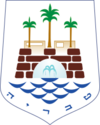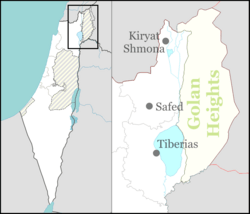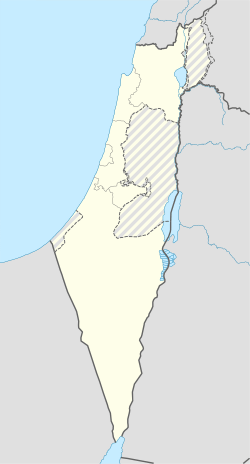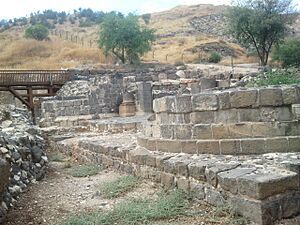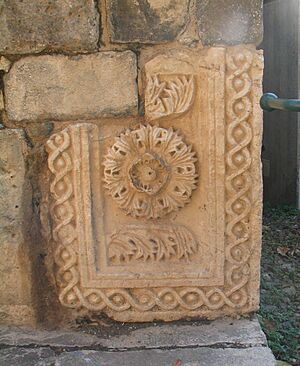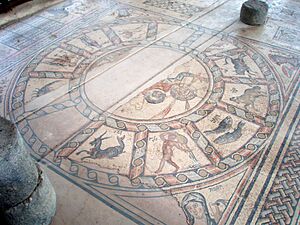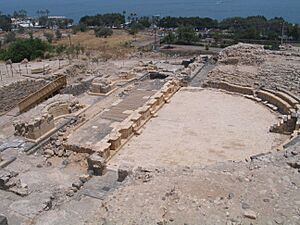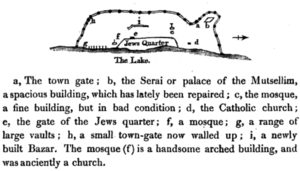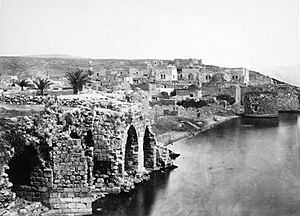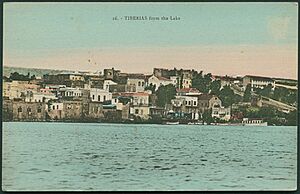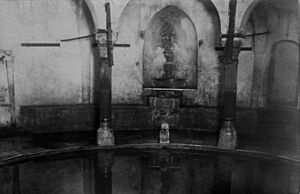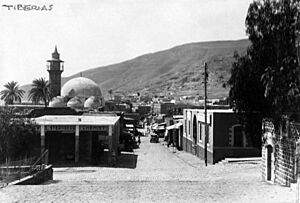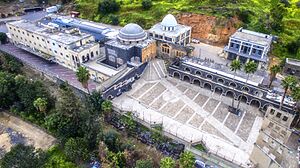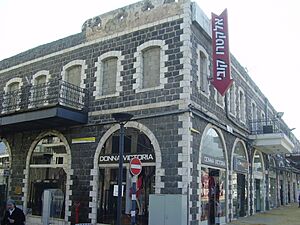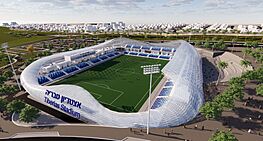Tiberias facts for kids
Quick facts for kids
Tiberias
|
||
|---|---|---|
|
City (from 1948)
|
||
| Hebrew transcription(s) | ||
| • Also spelled | Tveria, Tveriah (unofficial) | |
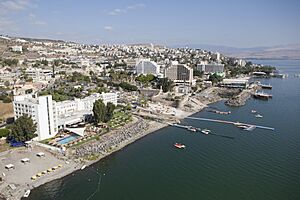 |
||
|
||
| Country | ||
| District | Northern | |
| Founded | 1200 BCE (Biblical Rakkath) 20 CE (Herodian city) |
|
| Area | ||
| • Total | 10,872 dunams (10.872 km2 or 4.198 sq mi) | |
| Population | ||
| • Total | 48,472 | |
| Name meaning | City of Tiberius | |
| Website | www.tiberias.muni.il | |
Tiberias is a city in Israel. It sits on the western shore of the Sea of Galilee. For a long time, it has been a very important Jewish center. Since the 1500s, it has been known as one of Judaism's Four Holy Cities. The other three are Jerusalem, Hebron, and Safed. In 2023, about 48,472 people lived there.
Tiberias was started around 20 CE by Herod Antipas. He named it after the Roman emperor Tiberius. After Jerusalem was destroyed in 70 CE, Tiberias became a main Jewish center. Many important Jewish writings, like parts of the Mishnah and Jerusalem Talmud, were created here.
The city grew during the early Islamic period. It became a busy trading center with many different cultures. However, earthquakes and wars caused it to become less important. A big earthquake in 1837 damaged the city a lot. It was rebuilt and grew steadily from the 1880s.
In the past, Tiberias had both Jewish and Arab people. During British rule, most people were Jewish, but there was a large Arab community. In 1948, fighting happened, and the Arab residents left. Today, almost everyone in Tiberias is Jewish.
Tiberias is now a popular place for tourists. People visit because it's near the Sea of Galilee and is important to Judaism and Christianity. It's also a center for business and industry. Nearby Hamat Tiberias has hot springs that people have used for healing for thousands of years.
Contents
History of Tiberias
Tiberias has a long and interesting history. It has seen many changes over thousands of years.
Ancient Times
Jewish tradition says Tiberias was built where an old Israelite village called Rakkath once stood. This village is mentioned in the Book of Joshua.
Roman Period
Herod Antipas founded Tiberias around 18–20 CE. He was a Roman-appointed king. He named the city after the Roman emperor Tiberius. The city was built near natural hot springs, which are now part of Hammat Tiberias.
At first, many non-Jewish people lived in Tiberias. Some very religious Jews did not want to live there because of an old cemetery. This made the area seem unclean to them. The Sea of Galilee soon became known as the Sea of Tiberias. However, Jewish people still called it Yam HaKineret.
In 61 CE, Herod Agrippa II took control of the city.
Jewish Revolts and Roman Rule
During the First Jewish–Roman War, Jewish rebels took over Tiberias. They stopped the city from being destroyed by the Roman army. Unlike many other cities, Tiberias was saved because its people chose not to fight Rome. After Jerusalem fell in 70 CE, many Jewish people moved to Galilee, and Tiberias became a mixed city.
Tiberias was not directly involved in the Bar Kokhba revolt (132–136 CE). This helped it survive. After Jews were expelled from Judea in 135 CE, Tiberias became a major Jewish cultural center.
In 145 CE, Rabbi Simeon bar Yochai made the city ritually clean. This allowed Jewish leaders to settle there. The Sanhedrin, a Jewish court, moved to Tiberias around 220 CE. It stayed there until 425 CE. Many important Jewish teachings, like the Jerusalem Talmud, were written in Tiberias. The city had 13 synagogues. Tombs of famous rabbis like Yohanan ben Zakkai, Akiva, and Maimonides are in Tiberias.
Byzantine Period
In the 6th century, Tiberias was still a center for Jewish learning. In 614, some Jewish people in Tiberias supported the Persian invaders against the Byzantine Empire. After the Byzantines won back the area in 628, Emperor Heraclius ordered a large killing of Jews. Many survivors fled to Egypt.
Early Muslim Period
Tiberias was taken by Arab forces in 634 CE. Half of the houses and churches were given to Muslims, and the other half to Christians. Tiberias became a regional capital until Beit She'an took its place. The Caliphate allowed 70 Jewish families to return to Jerusalem. This caused Tiberias to become less important for Jewish life.
The Umayyad rulers built a palace north of Tiberias. The city became active again in 749 after an earthquake destroyed Beit Shean. A large mosque was built. The 8th century was a golden age for Tiberias. It was a very open and diverse city. Jewish scholars here wrote down the rules for ancient Hebrew language.
A writer in 985 described Tiberias as a hot but healthy town. He mentioned eight natural hot baths. He said people with skin problems came to bathe there for three days to be cured.
In the 10th century, the city faced attacks from the Qarmatians. Later, the Fatimid Caliphate took control. Tiberias was known for exporting dried fruit, oil, and wine. It was also famous for making mats.
In 1033, another earthquake destroyed Tiberias. A visitor in 1047 described a city with strong walls and many buildings built right into the lake.
Crusader Period
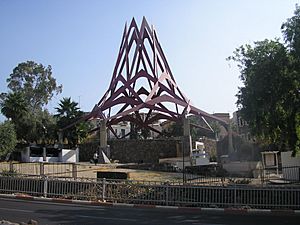
During the First Crusade, the Franks took Tiberias. It became the capital of the Principality of Galilee. In 1099, the city moved north to its current location. St. Peter's Church, built by the Crusaders, is still there today.
In the 12th century, about 50 Jewish families lived in Tiberias. They were led by rabbis. The best copies of the Torah were said to be found there.
In 1187, Saladin's army attacked Tiberias. After six days, the city fell. Saladin then defeated the Crusaders at the Battle of Hattin, near the city. Later, during the Third Crusade, the Crusaders took the city back.
Rabbi Moshe ben Maimon, also known as Maimonides, was a very important Jewish scholar. He died in 1204 in Egypt and was buried in Tiberias. His tomb is a major pilgrimage site.
Mamluk Period
In 1265, the Egyptian Mamluks took Tiberias from the Crusaders. They ruled the city until the Ottomans arrived in 1516.
Ottoman Period
In the 1500s, Tiberias was a small village. A rabbi who visited in 1522 said it was mostly ruined. There were only about ten or twelve Muslim families.
In 1558, a Jewish woman named Doña Gracia was given rights to collect taxes in Tiberias. She wanted to make the city a safe place for Jews. In 1561, her nephew Joseph Nasi encouraged Jews to settle there. They rebuilt the city walls and started a silk industry.
By 1596, Tiberias had 54 Muslim households. They grew wheat, barley, and fruit. In 1624, the city was destroyed by the Druze. This caused the Jewish community to leave.
In the 1720s, an Arab ruler named Zahir al-Umar made the town stronger. He invited Rabbi Chaim Abulafia to rebuild the Jewish community. The synagogue he built is still standing.
In 1775, Ahmed el-Jazzar brought peace to the area. In 1780, many Polish Jews settled in Tiberias. The city became a center for Jewish learning again. In 1837, a big earthquake destroyed much of the town. About 600 people died, including nearly 500 Jews. The city was rebuilt after this disaster.
British Mandate
In 1922, Tiberias had about 6,950 people. Most were Jews (4,427), with many Muslims (2,096) and Christians (422). At first, Jews and Arabs in Tiberias got along well. A modern spa was built in 1929.
A big flood in 1934 changed the city's look. Houses were built very close together near the lake. The flood brought mud and rocks, filling streets and buildings. Many people died. The city was rebuilt on higher ground. The British government planted the Swiss Forest to prevent future floods. A new seawall was also built.
In October 1938, Arab fighters killed 19 Jews in Tiberias. This happened during the 1936–39 Arab revolt in Palestine. In April 1948, Jewish forces attacked the city. British troops then helped evacuate the Arab population. After the war, the new Israeli government destroyed much of the Old City. This was due to hygiene issues and fear of Arabs returning. Many Jewish immigrants then settled in Tiberias.
State of Israel
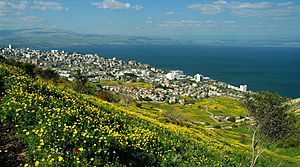
Since 1948, Tiberias has been almost entirely Jewish. Many Jews from Arab countries settled there. New housing was built for them.
Today, tourism is very important to Tiberias. It is a major center for Christian pilgrims and Israeli tourists. The old cemetery and synagogues also attract Jewish pilgrims.
Tiberias has a small port on the Sea of Galilee. It is used for fishing and tourism. The lake's water level has changed over time. In 2020, the lake's level rose back up.
People of Tiberias
As of August 2023, Tiberias had about 49,876 people. Most of the Jewish population today are Mizrahi Jews and Sephardi Jews. The city's population is growing by about 3.9% each year.
After Israel left Lebanon in 2000, many former South Lebanon Army soldiers and their families settled in Tiberias.
In 1780, Tiberias had about 4,000 people, with two-thirds being Jews. By 1912, the population reached 6,500. This included 4,500 Jews, 1,600 Muslims, and 400 Christians. In 1945, there were 6,000 Jews, 4,540 Muslims, and 760 Christians.
During the 1948 Arab-Israeli War, the Arab residents left Tiberias. Today, almost all of the people living in Tiberias are Jewish.
City Life and Preservation
Old Tiberias was destroyed many times by earthquakes. Much of what was built after the 1837 earthquake was damaged in the 1934 flood. Houses on the hills survived. In 1949, many old buildings were torn down.
After the Six-Day War, the city was developed a lot. A waterfront area, parks, shops, restaurants, and hotels were built. Several old churches, mosques, and synagogues have been carefully kept. Parts of the ancient wall and old buildings made of black stone are also preserved.
Discoveries and Archaeology
Archaeologists have found many interesting things in Tiberias.
- A 2,000-year-old Roman theatre was found south of the city. It could seat over 7,000 people.
- In 2004, a building from the 3rd century CE was found. It might have been where the Sanhedrin met.
- In 2018, an underground Jewish tomb was discovered. It was about 1,900 to 2,000 years old. Names of the dead were written in Greek.
- In 2021, the foundations of a mosque from the early Muslim period were found. It was built around 670 CE.
Geography and Climate
Tiberias is located on the shore of the Sea of Galilee. It is in the Jordan Rift Valley, which is below sea level. The city's elevation ranges from about 200 meters below to 200 meters above sea level.
Tiberias has a hot, dry climate. Summers are very hot, with average high temperatures of 38°C (100°F) in July and August. Winters are mild, with temperatures from 10°C to 18°C (50°F to 64°F). The highest temperature ever recorded was 48°C (118°F).
| Climate data for Tiberias, Israel (1981–2010 normals), | |||||||||||||
|---|---|---|---|---|---|---|---|---|---|---|---|---|---|
| Month | Jan | Feb | Mar | Apr | May | Jun | Jul | Aug | Sep | Oct | Nov | Dec | Year |
| Mean daily maximum °C (°F) | 18.1 (64.6) |
19.3 (66.7) |
23.1 (73.6) |
27.8 (82.0) |
33.2 (91.8) |
36.5 (97.7) |
38.0 (100.4) |
38.0 (100.4) |
35.9 (96.6) |
31.6 (88.9) |
25.7 (78.3) |
20.0 (68.0) |
28.9 (84.0) |
| Daily mean °C (°F) | 14.3 (57.7) |
14.7 (58.5) |
17.6 (63.7) |
21.5 (70.7) |
26.2 (79.2) |
29.5 (85.1) |
31.5 (88.7) |
31.6 (88.9) |
29.6 (85.3) |
26.2 (79.2) |
21.0 (69.8) |
16.1 (61.0) |
23.3 (74.0) |
| Mean daily minimum °C (°F) | 10.4 (50.7) |
10.1 (50.2) |
12.0 (53.6) |
15.1 (59.2) |
19.1 (66.4) |
22.5 (72.5) |
25.0 (77.0) |
25.2 (77.4) |
23.3 (73.9) |
20.8 (69.4) |
16.3 (61.3) |
12.1 (53.8) |
17.7 (63.9) |
| Average precipitation mm (inches) | 106.9 (4.21) |
90.2 (3.55) |
55.5 (2.19) |
17.6 (0.69) |
3.9 (0.15) |
0.1 (0.00) |
0.0 (0.0) |
0.0 (0.0) |
0.6 (0.02) |
17.4 (0.69) |
51.9 (2.04) |
93.0 (3.66) |
437.1 (17.21) |
| Source: WMO | |||||||||||||
Tiberias is located near the Dead Sea Transform, which is a fault line. This means it is at risk of earthquakes. Earthquakes have damaged the city many times throughout history.
Sports in Tiberias
Tiberias has a history with football (soccer).
- The first football club, Maccabi Tiberias F.C., started in 1925. It closed in the 1990s.
- Hapoel Tiberias F.C. played in Israel's top football league in the 1960s and 1980s. It also closed due to money problems.
- A new club, Ironi Tiberias F.C., was formed. It currently plays in Liga Leumit.
- Jamie Heaslip, a famous Irish rugby player, was born in Tiberias.
The Tiberias Marathon is a yearly running race. It takes place along the Sea of Galilee. About 1000 people compete. The course is about 200 meters (656 feet) below sea level, making it the lowest marathon course in the world.
Sister Cities
Tiberias is connected with these cities around the world:
 Great Neck, United States (2002)
Great Neck, United States (2002) Milwaukee, United States (2000)
Milwaukee, United States (2000) Montecatini Terme, Italy (1979)
Montecatini Terme, Italy (1979) Montpellier, France (1983)
Montpellier, France (1983) Saint Paul, Minnesota, United States
Saint Paul, Minnesota, United States Saint-Raphaël, France (2006)
Saint-Raphaël, France (2006) Tulsa, United States (1990)
Tulsa, United States (1990) Worms, Germany (1986)
Worms, Germany (1986) Wuxi, China (2006)
Wuxi, China (2006)
Famous People from Tiberias
Many notable people have lived in or are from Tiberias:
- Rabbi Meir Baal HaNes (2nd century CE), a wise Jewish leader.
- Johanan bar Nappaha (180–279), a famous rabbi.
- Donna Gracia Mendes Nasi (1510–1569), a wealthy Jewish helper of others.
- Zahir al-Umar (c. 1689–1775), an Arab ruler of northern Palestine.
- Jamie Heaslip (born 1983), an Irish rugby player.
- Menahem Golan (1929–2014), a film producer and director.
- Gadi Eizenkot (born 1960), a former chief of the Israeli army.
- Moshe Peretz (born 1983), a popular singer.
Images for kids
-
"Leaning tower" at SE corner of Zahir al-Umar's walls
See also
 In Spanish: Tiberíades para niños
In Spanish: Tiberíades para niños


